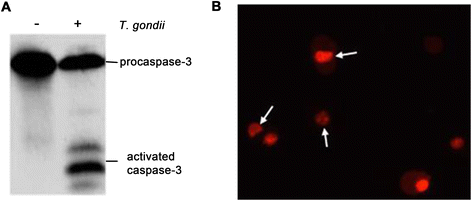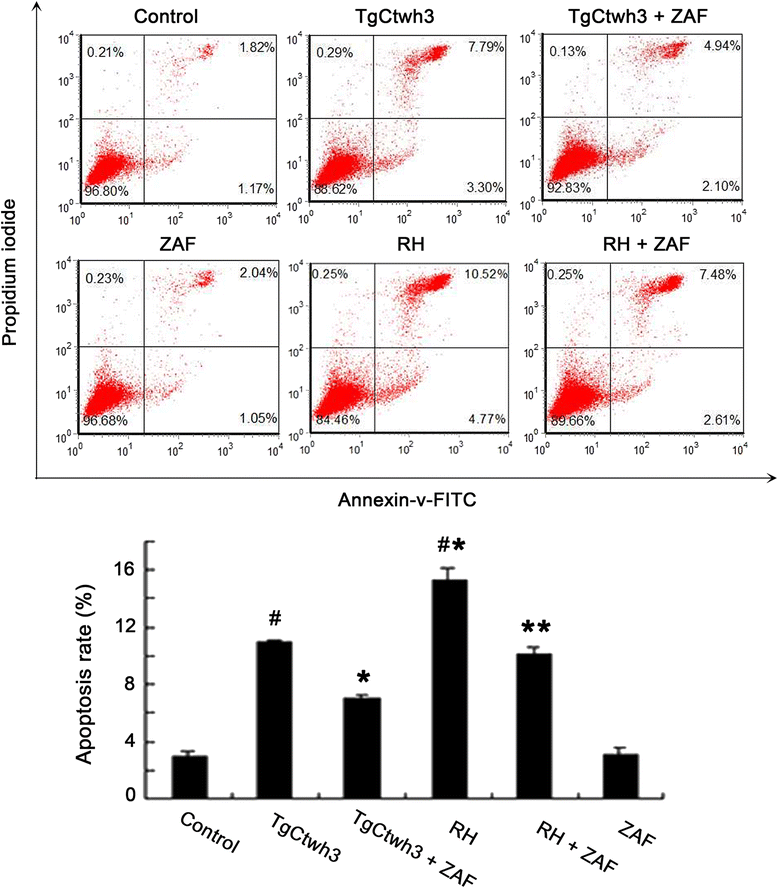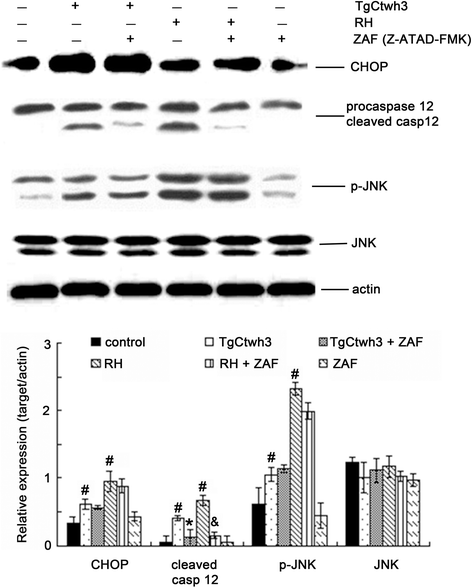Toxoplasma gondii prevalent in China induce weaker apoptosis of neural stem cells C17.2 via endoplasmic reticulum stress (ERS) signaling pathways
- PMID: 25649541
- PMCID: PMC4322664
- DOI: 10.1186/s13071-015-0670-3
Toxoplasma gondii prevalent in China induce weaker apoptosis of neural stem cells C17.2 via endoplasmic reticulum stress (ERS) signaling pathways
Abstract
Background: Toxoplasma gondii, an obligate intracellular pathogen, has a strong affinity for the nervous system. TgCtwh3, a representative Chinese 1 Toxoplasma strain prevalent in China, has the polymorphic features of the effectors ROP16I/III with type I and GRA15II with type II Toxoplasma strains. The interaction of this atypical strain with host cells remains extremely elusive.
Methods: Using a transwell system, neural stem cells C17.2 were co-cultured with the tachyzoites of TgCtwh3 or standard type I RH strain. The apoptosis levels of C17.2 cells and the expression levels of related proteins in the endoplasmic reticulum stress (ERS)-mediated pathway were detected by flow cytometry and Western blotting.
Results: The apoptosis level of C17.2 cells co-cultured with TgCtwh3 had a significant increase compared to the negative control group; however, the apoptosis level in the TgCtwh3 group was significantly lower than that in the RH co-culture group. Western blotting analyses reveal that, after the C17.2 cells were co-cultured with TgCtwh3 and RH tachyzoites, the expression levels of caspase-12, CHOP and p-JNK in the cells increased significantly when compared to the control groups. After the pretreatment of Z-ATAD-FMK, an inhibitor of caspase-12, the apoptosis level of the C17.2 cells co-cultured with TgCtwh3 or RH tachyzoites had an apparent decline, and correspondingly, the expression levels of those related proteins were notably decreased.
Conclusions: Our findings suggest that TgCtwh3 may induce the apoptosis of the C17.2 cells by up-regulation of caspase-12, CHOP, and p-JNK, which are associated with ERS signaling pathways. This work contributes to better understanding the possible mechanism of brain pathology induced by T. gondii Chinese 1 isolates prevalent in China, and also reveals the potential value of ERS inhibitors to treat such related diseases in the future.
Figures





Similar articles
-
Toxoplasma gondii induce apoptosis of neural stem cells via endoplasmic reticulum stress pathway.Parasitology. 2014 Jun;141(7):988-95. doi: 10.1017/S0031182014000183. Epub 2014 Mar 10. Parasitology. 2014. PMID: 24612639
-
T. gondii rhoptry protein ROP18 induces apoptosis of neural cells via endoplasmic reticulum stress pathway.Parasit Vectors. 2015 Oct 21;8:554. doi: 10.1186/s13071-015-1103-z. Parasit Vectors. 2015. PMID: 26489755 Free PMC article.
-
Reactive oxygen species-triggered trophoblast apoptosis is initiated by endoplasmic reticulum stress via activation of caspase-12, CHOP, and the JNK pathway in Toxoplasma gondii infection in mice.Infect Immun. 2012 Jun;80(6):2121-32. doi: 10.1128/IAI.06295-11. Epub 2012 Apr 2. Infect Immun. 2012. Retraction in: Infect Immun. 2015 Apr;83(4):1735. doi: 10.1128/IAI.00118-15. PMID: 22473610 Free PMC article. Retracted.
-
Toxoplasma gondii dense granule protein 3 promotes endoplasmic reticulum stress-induced apoptosis by activating the PERK pathway.Parasit Vectors. 2022 Aug 2;15(1):276. doi: 10.1186/s13071-022-05394-5. Parasit Vectors. 2022. PMID: 35918751 Free PMC article.
-
Toxoplasma gondii: a protozoan for the nineties.Infect Immun. 1993 Apr;61(4):1169-72. doi: 10.1128/iai.61.4.1169-1172.1993. Infect Immun. 1993. PMID: 8454321 Free PMC article. Review. No abstract available.
Cited by
-
Toxoplasma gondii dense granule protein 15 induces apoptosis in choriocarcinoma JEG-3 cells through endoplasmic reticulum stress.Parasit Vectors. 2018 Apr 17;11(1):251. doi: 10.1186/s13071-018-2835-3. Parasit Vectors. 2018. PMID: 29665822 Free PMC article.
-
Regulatory effects of Trichinella spiralis and a serine protease inhibitor on the endoplasmic reticulum stress response of intestinal epithelial cells.Vet Res. 2022 Mar 3;53(1):18. doi: 10.1186/s13567-022-01036-x. Vet Res. 2022. PMID: 35241168 Free PMC article.
-
Encephalitis is mediated by ROP18 of Toxoplasma gondii, a severe pathogen in AIDS patients.Proc Natl Acad Sci U S A. 2018 Jun 5;115(23):E5344-E5352. doi: 10.1073/pnas.1801118115. Epub 2018 May 21. Proc Natl Acad Sci U S A. 2018. PMID: 29784816 Free PMC article.
-
Endoplasmic Reticulum Stress, a Target for Drug Design and Drug Resistance in Parasitosis.Front Microbiol. 2021 May 31;12:670874. doi: 10.3389/fmicb.2021.670874. eCollection 2021. Front Microbiol. 2021. PMID: 34135878 Free PMC article. Review.
-
Parasitological, Molecular, and Histopathological Investigation of the Potential Activity of Propolis and Wheat Germ Oil against Acute Toxoplasmosis in Mice.Pharmaceutics. 2023 Feb 1;15(2):478. doi: 10.3390/pharmaceutics15020478. Pharmaceutics. 2023. PMID: 36839800 Free PMC article.
References
-
- Dubey JP. Toxoplasmosis of animals and humans. 2nd ed. CRC Press; 2010.
Publication types
MeSH terms
Substances
LinkOut - more resources
Full Text Sources
Other Literature Sources
Medical
Research Materials

